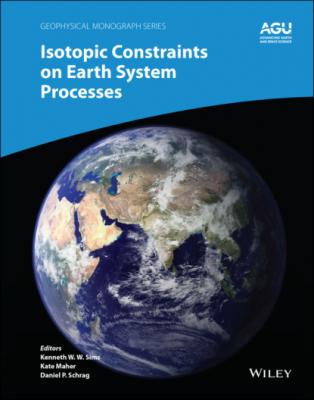ТОП просматриваемых книг сайта:
Isotopic Constraints on Earth System Processes. Группа авторов
Читать онлайн.Название Isotopic Constraints on Earth System Processes
Год выпуска 0
isbn 9781119594963
Автор произведения Группа авторов
Издательство John Wiley & Sons Limited
Onsager (1945) showed that a way to deal with transport in a multi‐component system is to express the diffusive flux of a component as a linear combination of the concentration gradients of all the independent components in the system. The one‐dimensional diffusive flux of component i in an n‐component liquid is then given by
where Dij are elements of a (n‐1) by (n‐1) diffusion matrix with the nth component taken as the dependent component. For example, equation 1.3 for the ternary system CaO‐Al2O3‐SiO2 can be written in matrix form as
(1.4)
when SiO2 is taken as the dependent component. The flux of the SiO2 can be calculated using
Another issue that is especially relevant in natural silicate liquids is that the driving force for chemical diffusion is chemical potential gradients ∇ μ i ( μ i now denotes chemical potential, not reduced mass). The more general version of equation 1.1 is
(1.5)
where the Li is called the phenomenological coefficient for diffusion and
1.2.2. Effective Binary Diffusion Coefficients
When the formulation of the diffusive flux given previously is applied to multi‐component geologically relevant silicate materials, one is faced with the problem that to date only one complete diffusion matrix for an igneous melt (an 8‐component basaltic melt) has been reported (Guo & Zhang, 2018). When there is a lack of a full diffusion matrix for a specific system of interest, what is commonly done is to represent the multi‐component system as if it were a binary system made up of the component of interest with all the other components taken together as a second component. The mass flux in such a pseudo‐binary system will involve a single diffusion coefficient (i.e., n = 2 in equation 1.3) and thus given a diffusion profile of a component i one can in most cases fit the data using equation 1.2 to determine the effective binary diffusion coefficient
1.2.3. Self‐Diffusion Coefficients
A very basic type of diffusion coefficient is the self‐diffusion coefficient that measures of the intrinsic mobility of a species. A common experimental approach for measuring self‐diffusion coefficients is to locally alter the isotopic composition of the element of interest in an otherwise homogeneous medium and observe the rate at which the isotopic difference spreads. In effect, this eliminates all diffusive coupling to the other species because their gradients are all zero. The self‐diffusion coefficient

